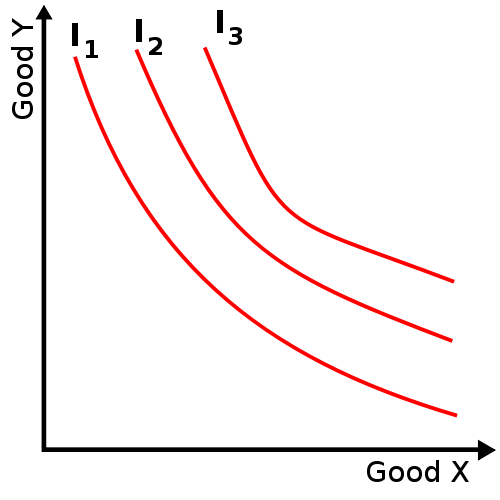The economics of altruism
Economists get a bad rap for assuming in their models that people are only interested in themselves. The much-maligned Homo economicus uses all information at their disposal to make decisions that maximize their own well-being, or what economists call utility. But actually, some economists have described how altruism can fit neatly into the equations that are used to describe utility.
Utility functions and indifference maps describe what combinations of two goods a person has a higher or lower preference for. The goods could be anything we would spend money on or make an effort to get—for example, pizza and beer. Let’s say you have a six-pack of beer and a slice of pizza. If you’d rather have five beers and two slices of pizza, then that combination would have a higher utility for you, and you ought to be willing to trade one of your beers for a second slice of pizza.

The three lines on this indifference map are called indifference curves. Each one describes combinations of the two goods that produce equal utility for a given person, so that person should be indifferent as to which particular combination along that curve they get. The combinations on curve I2 produce higher utility than the combinations on curve I1, and the combinations on curve I3 produce even higher utility.
If we say Good Y is beer and Good X is pizza, then the example I gave above would make sense if five beers and two slices of pizza were on indifference curve I2 and six beers and one slice of pizza were on indifference curve I1, so by trading a beer for a slice of pizza, you could go from a situation of lower personal utility to one of higher utility.
In this example, the two goods are material things (pizza and beer), but they could also be something immaterial—like free time, for example. When we accept a wage for doing a job, we are trading some of our time and effort for a certain amount of money. If the wage is high enough for us to take the job, that trade-off must produce a combination of time and money with higher utility than the combination of more free time and less money that we had before we took the job.
The economists who study altruism have applied these principles to examples in which one of the two goods is another person’s utility. The most basic form of that sort of utility function is:
Ui (Uj,xi)
This expresses that my utility (Ui) is a function of a trade-off between the utility of some other person (Uj) and the totality of my own consumption (xi). In other words, if I do indeed care about another person’s well-being, then I should be willing to give up something (money, time, etc.) to make their life better. And an indifference map where their utility and my consumption are the X and Y axes should be able to describe what combinations I prefer of a certain amount of my own consumption and a certain level of their utility. As a rational economic actor (Homo economicus), I should only be willing to trade some amount of my own consumption to increase that other person’s utility, if the new combination of my own consumption and their utility moves my situation from an indifference curve of lower personal utility to one of higher personal utility.
This means that basic economics can account for altruistic behaviors, simply by assuming that other people’s utility factors into our own utility functions. We can be Homo economicus and still care about what happens to the other people in our lives. Helping other people increases our own utility, but it’s still an altruistic act as long as our sincere motivation is to help another person. Cool, no? In the next post, I’ll consider some examples of this.
© Joel Benington, 2011.
The above image is used under a Creative Commons Attribution ShareAlike 3.0 license.


[…] the last post, I described how altruistic behaviors can be explained economically, in terms of utility functions […]
Using the economics of altruism « Pro-Human Extremist
June 2, 2011 at 6:46 pm
[…] can be explained based on a simple economic model of human altruism, in which voters have a utility function that includes other people’s utility. By voting for a social safety net, we increase the utility […]
Three cheers for the “warm glow”! « Pro-Human Extremist
June 20, 2011 at 10:16 pm